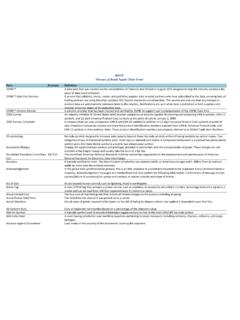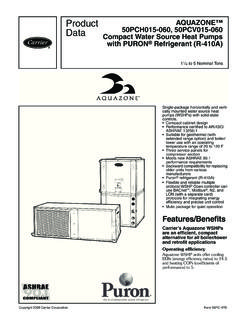Transcription of Water Utility Asset Management: A Guide for Development ...
1 Water Utility Asset ManagementA Guide for Development PractitionersExperiences of the Asian Development Bank (ADB) in the Water supply sector show the consequences of inadequate Asset management, such as lack of customer coverage and high nonrevenue Water ratios . One response is lending to allow for new infrastructure. Some immediate benefits may be evident, but sustainability is at risk unless better Asset management is part of the solution. This Guide provides ADB s perspective on Asset management, as well as an overview of the concept, processes, and systems of Asset management, followed by a presentation of case studies about what utilities have done to manage their assets, including the results achieved. About the Asian Development BankADB s vision is an Asia and Pacific region free of poverty. Its mission is to help its developing member countries reduce poverty and improve the quality of life of their people.
2 Despitethe region s many successes, it remains home to two-thirds of the world s poor: billion people who live on less than $2 a day, with 828 million struggling on less than $ a day. ADB is committed to reducing poverty through inclusive economic growth, environmentally sustainable growth, and regional in Manila, ADB is owned by 67 members, including 48 from the region. Its main instruments for helping its developing member countries are policy dialogue, loans, equity investments, guarantees, grants, and technical Development Bank6 ADB Avenue, Mandaluyong City1550 Metro Manila, Printed on recycled in the PhilippinesISBN 978-92-9254-399-0 Water Utility AssetManagementA Guide for Development PractitionersPrinted on recycled paper 2013 Asian Development BankAll rights reserved. Published in in the Philippines. ISBN 978-92-9254-399-0 (Print), 978-92-9254-400-3 (PDF)Publication Stock No.
3 TIM136104 Cataloging-In-Publication DataAsian Development Bank. Water Utility Asset management: A Guide for Development City, Philippines: Asian Development Bank, Water management. 2. Water supply. I. Asian Development views expressed in this publication are those of the authors and do not necessarily reflect the views and policies of the Asian Development Bank (ADB) or its Board of Governors or the governments they does not guarantee the accuracy of the data included in this publication and accepts no responsibility for any consequence of their making any designation of or reference to a particular territory or geographic area, or by using the term country in this document, ADB does not intend to make any judgments as to the legal or other status of any territory or encourages printing or copying information exclusively for personal and noncommercial use with proper acknowledgment of ADB.
4 Users are restricted from reselling, redistributing, or creating derivative works for commercial purposes without the express, written consent of :In this publication, $ refers to US dollars, unless otherwise stated. 6 ADB Avenue, Mandaluyong City1550 Metro Manila, PhilippinesTel +63 2 632 4444 Fax +63 2 636 orders, please contact: Public Information CenterFax +63 2 636 Figures, and BoxesvAbbreviationsviBackground1 Introduction to Asset Management3 Chapter I: A Brief Overview of Asset and Define Requirements51. Asset Policy52. Service Levels63. Demand Forecast74. Understanding Asset Base75. Asset Condition86. Identify Asset Risk9B. Develop Asset Management Life-Cycle Strategies 111. Decision-Making Techniques 112. Operational Strategies and Plans123. Maintenance Strategies and Plans134. Capital Works Strategies 145. Financial and Funding Strategies15C. Asset Management Enablers 151.
5 Teams152. Plans163. Systems164. Service Delivery Models 165. Quality Management and Continuous Improvement 16D. Conclusion18ivChapter II: Asset Management Case Histories Water and Sanitation Agency, Rawalpindi, Pakistan 19B. Davao City Water District, Davao, Philippines 20C. Barwon Water , State of Victoria, Australia 22D. National Water Supply and Drainage Board, Sri Lanka 23E. Hai Phong Water Supply Company, Hai Phong, Viet Nam25 Chapter III: ADB Perspectives27 Appendixes1. Computer-Based Asset Management Systems322. Asset Management Self-Diagnostic Guide333. Benchmarking37vTables, Figures, and BoxesTables1 Cascading of Service-Level Targets62 Simple Condition Ranking93 Example of Risk Ratings10A2 Asset Management Self-Diagnostic Guide33 Figures1 Asset Management Explanation Structure52 Illustration of Asset Management System Modules73 Asset Hierarchy for Classifying Assets84 Illustration of Asset Condition95 Risk Management Process106 Comparative Life-Cycle Cumulative Costs117 Illustration of Life-Cycle Cost Pattern128 Maintenance Management Overview139 Launching Maintenance1410 Capital Works Overview1411 Steps to Achieve Improvements1712 Asset Management Problem Analysis2713 Indicative Design and Monitoring Framework28 Boxes1 Asset Policy Example62 Indicative Terms of Reference for Consultants to Assist in an Asset Management Improvement Project 293 Asset Management Issues and Proposed Solutions 30viAbbreviationsDCWD Davao City Water DistrictGIS geographic
6 Information systemHPWSC Hai Phong Water Supply CompanyISO International Organization for StandardizationNWSDB National Water Supply and Drainage BoardRWASA Rawalpindi Water and Sanitation Agency1 BackgroundMany of today s Water Utility managers face the challenge of cutting their unacceptably high levels of nonrevenue Water . Aside from decreasing revenue, money for investment, productivity, and service delivery, nonrevenue Water also increases the cost of the delivered addition to reducing nonrevenue Water , Water Utility managers must (i) raise their service levels closer to 24 hours a day, 7 days a week, to meet the expectations of households, commerce, and industry; (ii)expand distribution networks to cope with population growth; (iii) finance the timely replacement and maintenance of existing assets; and (iv) treat heavily polluted way an organization manages its assets determines its success in addressing these challenges.
7 A Utility can improve and sustain the expected level of service, reduce Water losses, cut unit costs, and fairly justify tariff rates if it knows what assets it has and needs, when and how to maintain or replace those assets, and how the assets should be concept is easier stated than achieved. Policies, plans, practices, and systems need to be put in place and applied by skilled personnel who are committed to caring for assets and meeting service Asset management is necessary because poor Asset management leads to Water losses that exceed industry good practice; less than 24/7 Water supply service and frequent concerns over Water quality; incomplete, inaccurate, and unreliable Asset records; maintenance that mostly addresses breakdowns; minimal Asset planning that is not based on sound analysis and records; and costs, and ultimately prices, that are higher than they should is no single rapid solution to remedy poor Asset management.
8 Although some short-term actions can be taken to reduce nonrevenue Water , tackling the underlying issue of poor Asset management requires a time frame of 3 7 years. It normally involves dealing with a considerable number of different assets, clearing a backlog of poor Asset information, and effecting a change in system and sequence of steps is needed to address poor Asset management. First, the Utility s commitment to improve and its degree of decision-making autonomy must be assessed. This may be gauged by observing evidence of other change activities and through discussions with management on the Asset , staffing, or change decisions that require referral for approval to position holders outside the organization. Second, the Utility s current Asset management status needs to be established. There are a number of checklists and guidance manuals available to help undertake this step.
9 Third, management buy-in for change must be obtained through workshops and senior management meetings to ensure that everyone shares the same way of thinking. Change plans will be developed at such workshops, based on the diagnosis, what is feasible within different time frames, and the need to build more and more support. Fourth, the Utility should form a change team, usually 2engaging an outside expert to help Guide the implementation process, which will deal with (i) Asset inventory and records, (ii) computer-based systems including geographic information systems (GIS), (iii) Asset policies including acquisition and disposal, (iv) decision rules to address Asset criticality and risk, (v) Asset planning, (iv) key performance indicators, and (v)operations and skills Asset management involves most people in the organization. They need to carry on with their daily work while also tackling a substantial change program.
10 Despite these significant barriers, the change can and should be done to ensure utilities deliver promised services. Experience also shows that a strong external regulator that monitors service delivery for the community can help sustain good Guide focuses on medium-sized and large operators. It discusses techniques that apply to situations where Asset types and conditions vary widely and in-house engineering and financial skills exist. The fundamentals, however, apply to all utilities. Asset management gives smaller utilities the opportunity to introduce good Asset recording systems; ensure regular maintenance; identify critical assets; manage the risk of their breakdown; and measure Asset performance, especially nonrevenue Water , as an indicator of good Asset Guide aims to provide a brief overview of the concept, processes, and systems of Asset management, including self-diagnosis to help Utility managers and project designers identify change priorities (Chapter I); case studies about what utilities have done to manage their assets, including the results they achieved or did not achieve (Chapter II).














